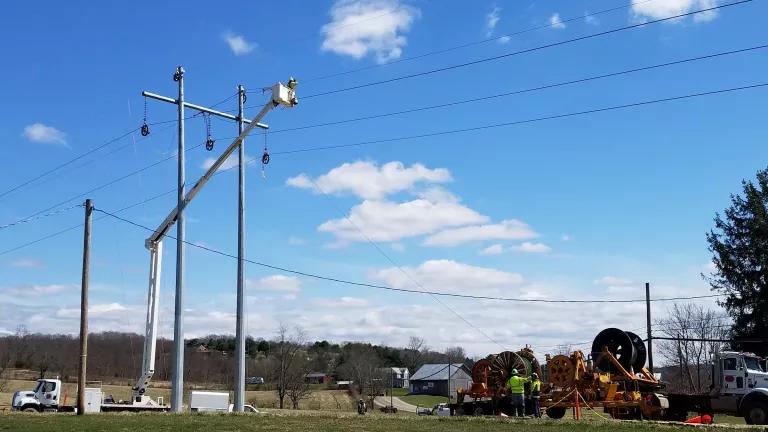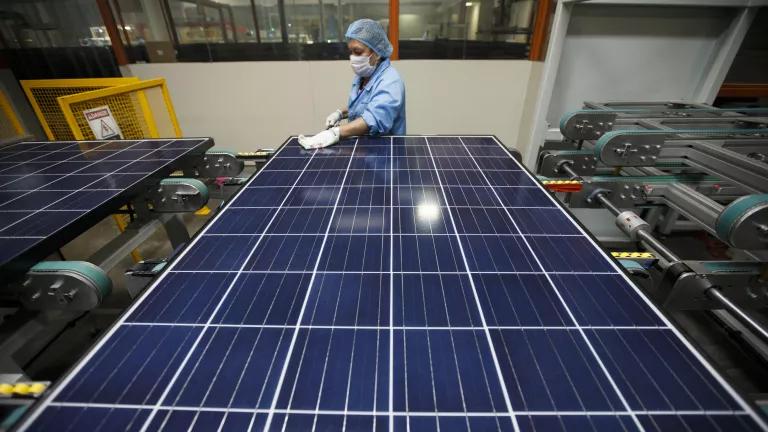Puerto Rico and USVI Need Funding for Long-Term Solutions
This post, authored by Arjun Krishnaswami, originally appeared as a guest post in Luis Martinez's blog.
Long before the recent hurricanes, the electric utilities in Puerto Rico and the U.S. Virgin Islands (USVI) struggled to meet customer needs. Hurricanes Irma and Maria exacerbated the problem immensely; 1.2 million households remain without power over a month later. Our fellow Americans deserve more than a Band-Aid solution to a long-term problem. The federal government should fund a thorough rebuilding effort that provides immediate relief while increasing resilience, reliability, and energy independence.
Long-troubled power systems
Puerto Rico and the USVI depend heavily on imported fossil fuels. Puerto Rico generated two-thirds of its electricity from imported petroleum until 2012, when the utility added a natural gas generating unit. In 2016, the island generated 47 percent of its electricity using petroleum and met most of the remaining demand with imported natural gas and coal. Likewise, almost all of USVI’s energy comes from imported petroleum or propane.
Island residents face high and volatile electricity costs. Electricity rates in Puerto Rico and the USVI are two to three times higher than the U.S. average—26 and 34 cents per kilowatt-hour (kWh), compared to 13 cents/kWh across the United States. Moreover, the prices fluctuate with the price of oil; for example, global petroleum prices in 2008 drove USVI rates to 50 cents/kWh, five times greater than the U.S. average at the time.
Puerto Rico’s power system is old, heavily polluting, inefficient, and unreliable:
- Puerto Rican plants are 24 years older than the average U.S. plant.
- Many oil-fired units fail to meet Environmental Protection Agency’s Mercury and Air Toxics Standard.
- The grid is the least efficient in the country.
- The average Puerto Rican experiences four to five times as many service interruptions as the U.S. average.
The challenges and shortcomings are troubling but not surprising, given the resources available to the utilities. The Puerto Rico Electric Power Authority (PREPA), the public electric utility, was $9 billion in debt before going bankrupt in July. The utility’s rates do not cover its costs, and its budget is focused on fuel purchases and administrative spending rather than repairs and maintenance. Moreover, alleged corruption may have further diverted spending from the grid.
Despite the need for more investment, PREPA’s funds and labor are decreasing. The utility’s 2015-2016 budget was lower than it had been since 2010, and its workforce decreased by 22 percent from 2014 to 2016. Many skilled laborers have left the utility (and the island) because of insufficient funding and the abnormally high risk of injury and death that PREPA employees face.
The USVI is in better financial shape than Puerto Rico, but its utility—the Water and Power Authority (WAPA)—still maintains $253 million in debt, while the government as a whole faces a potential debt crisis.
The existing plans to upgrade the grid will maintain the territories’ dependence on imported fuels. Before the hurricanes, PREPA was considering three long-term plans that would primarily use imported natural gas to power the island. Similarly, WAPA has been transitioning the USVI towards reliance on propane instead of petroleum.
Rebuilding with an eye for the future
With over half of Puerto Rico’s 3.4 million residents still lacking power, the first priority is to address the delay in humanitarian relief. But simply rebuilding the grid in its original form will perpetuate the unreliable system and high electric bills—and will do nothing to prevent future catastrophes.
The disaster recovery efforts can meet the islands’ urgent energy needs by rebuilding a cleaner, stronger, and more resilient grid, and the federal government should support these efforts.
Renewable energy will provide energy independence and make customers less vulnerable to fluctuations in fuel prices. Renewable resources are cost effective in the territories; wind and solar cost 16 and 19 cents/kWh in Puerto Rico, lower than the current island average of 26 cents/kWh for all fuel types. The National Renewable Energy Lab (NREL) estimates that the island could develop 840 MW of capacity from wind resources and 1,100 MW from solar (out of 2,700 MW of demand), and a 2009 study argued that wind and solar could supply 100 percent of Puerto Rico’s electricity needs.
Puerto Rico has received a slurry of recommendations for how to rebuild the grid. Federal funding should enable the islands to carry out these recommendations and build a power system that reliably meets residents’ needs and protects them from future storms.
The federal government should fund:
- Replacement of emergency diesel- and gas-fired generators with renewable backup power and storage through Federal Emergency Management Agency (FEMA) Public Assistance grants and Hazard Mitigation grants,
- Partial replacement of damaged fossil fuel-fired generation with renewable energy through FEMA Public Assistance grants, and
- Efficiency measures and solar panels for rebuilt homes through Housing and Urban Development Community Development Block Grants and the Weatherization Assistance Program.
Puerto Rico’s governor requested $94 billion today through several of the above pathways; legislators should work with him and other leaders to fund a thorough recovery effort.
Federal leaders can also help the islands modernize their grids through technical assistance and establishment of a grant program for advanced grid technologies. The islands should move from a traditional grid infrastructure to a more localized system that relies on distributed (local) energy resources such as energy efficiency, demand response, and onsite solar panels. The modernized grid should also incorporate microgrids to increase resilience of critical infrastructure, provide power to isolated communities more easily, and make recovery efforts faster and more effective.
Hawaii provides a useful example of similar challenges and solutions. The state has long depended on imported petroleum but now boasts some of the most ambitious energy-transition goals in the country: 100 percent renewables by 2045 and an extensive, six-year grid-modernization plan. Hawaii’s plan is a work in progress, and the state will need significant investment and creative solutions to realize its goals. But the government has taken steps that show it is serious about rebuilding its grid for resilience, energy independence, and a low-carbon future, and Puerto Rico and the USVI should—with federal support—follow suit.




